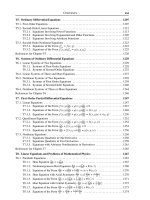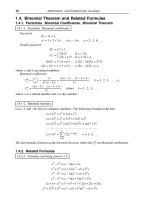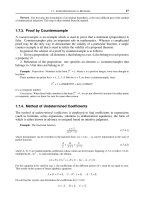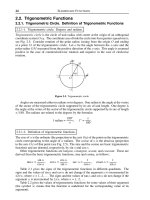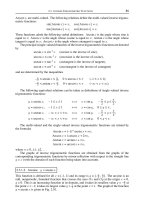Handbook of mathematics for engineers and scienteists part 198 pdf
Bạn đang xem bản rút gọn của tài liệu. Xem và tải ngay bản đầy đủ của tài liệu tại đây (297.01 KB, 7 trang )
T10.3. NONLINEAR SYSTEMS OF TWO SECOND-ORDER EQUATIONS 1347
6a.
∂u
∂t
= a
∂
2
u
∂x
2
+ uf
u
w
,
∂w
∂t
= a
∂
2
w
∂x
2
+ wg
u
w
.
This system is a special case of system T10.3.1.6 with b = a and hence it admits the above
solutions given in Items 1
◦
–5
◦
. In addition, it has some interesting properties and other
solutions, which are given below.
Suppose u = u(x, t), w = w(x, t) is a solution of the system. Then the functions
u
1
= Au( x + C
1
, t + C
2
), w
1
= Aw( x + C
1
, t + C
2
);
u
2
=exp(λx + aλ
2
t)u(x + 2aλt, t), w
2
=exp(λx + aλ
2
t)w(x + 2aλt, t),
where A, C
1
, C
2
,andλ are arbitrary constants, are also solutions of these equations.
6
◦
. Point-source solution:
u =exp
–
x
2
4at
ϕ(t), w =exp
–
x
2
4at
ψ(t),
where the functions ϕ = ϕ(t)andψ = ψ(t) are determined by the autonomous system of
ordinary differential equations
ϕ
t
=–
1
2t
ϕ + ϕf
ϕ
ψ
,
ψ
t
=–
1
2t
ψ + ψg
ϕ
ψ
.
7
◦
. Functional separable solution:
u =exp
kxt +
2
3
ak
2
t
3
– λt
y(ξ),
w =exp
kxt +
2
3
ak
2
t
3
– λt
z(ξ),
ξ = x + akt
2
,
where k and λ are arbitrary constants, and the functions y = y(ξ)andz = z(ξ) are determined
by the autonomous system of ordinary differential equations
ay
ξξ
+(λ – kξ)y + yf(y/z)=0,
az
ξξ
+(λ – kξ)z + zg(y/z)=0.
8
◦
.Letk be a root of the algebraic (transcendental) equation
f(k)=g(k). (1)
Solution:
u = ke
λt
θ, w = e
λt
θ, λ = f (k),
where the function θ = θ(x, t) satisfies the linear heat equation
∂θ
∂t
= a
∂
2
θ
∂x
2
.
9
◦
. Periodic solution:
u = Ak exp(–μx)sin(βx – 2aβμt + B),
w = A exp(–μx)sin(βx – 2aβμt + B),
β =
μ
2
+
1
a
f(k),
where A, B,andμ are arbitrary constants, and k is a root of the algebraic (transcendental)
equation (1).
1348 SYSTEMS OF PARTIAL DIFFERENTIAL EQUATIONS
10
◦
. Solution:
u = ϕ(t)exp
g(ϕ(t)) dt
θ(x, t), w =exp
g(ϕ(t)) dt
θ(x, t),
where the function ϕ = ϕ(t) is described by the separable first-order nonlinear ordinary
differential equation
ϕ
t
=[f (ϕ)–g(ϕ)]ϕ,(2)
and the function θ = θ(x, t) satisfies the linear heat equation
∂θ
∂t
= a
∂
2
θ
∂x
2
.
To the particular solution ϕ = k = const of equation (2) there corresponds the solution
given in Item 8
◦
. The general solution of equation (2) is written out in implicit form as
dϕ
[f(ϕ)–g(ϕ)]ϕ
= t + C.
11
◦
. The transformation
u = a
1
U + b
1
W , w = a
2
U + b
2
W ,
where a
n
and b
n
are arbitrary constants (n = 1, 2), leads to an equation of similar form for
U and W .
7.
∂u
∂t
= a
∂
2
u
∂x
2
+ uf
u
w
+ g
u
w
,
∂w
∂t
= a
∂
2
w
∂x
2
+ wf
u
w
+ h
u
w
.
Let k be a root of the algebraic (transcendental) equation
g(k)=kh(k).
1
◦
. Solution with f (k) ≠ 0:
u(x, t)=k
exp[f (k)t]θ(x, t)–
h(k)
f(k)
, w(x, t)=exp[f(k)t]θ(x, t)–
h(k)
f(k)
,
where the function θ = θ(x, t) satisfies the linear heat equation
∂θ
∂t
= a
∂
2
θ
∂x
2
.(1)
2
◦
. Solution with f (k)=0:
u(x, t)=k[θ(x, t)+h(k)t], w(x, t)=θ(x, t)+h(k)t,
where the function θ = θ(x, t) satisfies the linear heat equation (1).
T10.3. NONLINEAR SYSTEMS OF TWO SECOND-ORDER EQUATIONS 1349
8.
∂u
∂t
= a
∂
2
u
∂x
2
+ uf
u
w
+
u
w
h
u
w
,
∂w
∂t
= a
∂
2
w
∂x
2
+ wg
u
w
+ h
u
w
.
Solution:
u = ϕ(t)G(t)
θ(x, t)+
h(ϕ)
G(t)
dt
, w = G(t)
θ(x, t)+
h(ϕ)
G(t)
dt
, G(t)=exp
g(ϕ) dt
,
where the function ϕ = ϕ(t) is described by the separable first-order nonlinear ordinary
differential equation
ϕ
t
=[f (ϕ)–g(ϕ)]ϕ,(1)
and the function θ = θ(x, t) satisfies the linear heat equation
∂θ
∂t
= a
∂
2
θ
∂x
2
.
The general solution of equation (1) is written out in implicit form as
dϕ
[f(ϕ)–g(ϕ)]ϕ
= t + C.
9.
∂u
∂t
= a
∂
2
u
∂x
2
+uf
1
w
u
+wg
1
w
u
,
∂w
∂t
= a
∂
2
w
∂x
2
+uf
2
w
u
+wg
2
w
u
.
Solution:
u=exp
[f
1
(ϕ)+ϕg
1
(ϕ)] dt
θ(x, t), w(x, t)=ϕ(t)exp
[f
1
(ϕ)+ϕg
1
(ϕ)] dt
θ(x, t),
where the function ϕ = ϕ(t) is described by the separable first-order nonlinear ordinary
differential equation
ϕ
t
= f
2
(ϕ)+ϕg
2
(ϕ)–ϕ[f
1
(ϕ)+ϕg
1
(ϕ)],
and the function θ = θ(x, t) satisfies the linear heat equation
∂θ
∂t
= a
∂
2
θ
∂x
2
.
10.
∂u
∂t
= a
∂
2
u
∂x
2
+ u
3
f
u
w
,
∂w
∂t
= a
∂
2
w
∂x
2
+ u
3
g
u
w
.
Solution:
u =(x + A)ϕ(z), w =(x + A)ψ(z), z = t +
1
6a
(x + A)
2
+ B,
where A and B are arbitrary constants, and the functions ϕ = ϕ(z)andψ = ψ(z)are
determined by the autonomous system of ordinary differential equations
ϕ
zz
+ 9aϕ
3
f(ϕ/ψ)=0,
ψ
zz
+ 9aϕ
3
g(ϕ/ψ)=0.
1350 SYSTEMS OF PARTIAL DIFFERENTIAL EQUATIONS
11.
∂u
∂t
=
∂
2
u
∂x
2
+ au – u
3
f
u
w
,
∂w
∂t
=
∂
2
w
∂x
2
+ aw – u
3
g
u
w
.
1
◦
. Solution with a > 0:
u =
C
1
exp
1
2
√
2ax+
3
2
at
– C
2
exp
–
1
2
√
2ax+
3
2
at
ϕ(z),
w =
C
1
exp
1
2
√
2ax+
3
2
at
– C
2
exp
–
1
2
√
2ax+
3
2
at
ψ(z),
z = C
1
exp
1
2
√
2ax+
3
2
at
+ C
2
exp
–
1
2
√
2ax+
3
2
at
+ C
3
,
where C
1
, C
2
,andC
3
are arbitrary constants, and the functions ϕ = ϕ(z)andψ = ψ(z)are
determined by the autonomous system of ordinary differential equations
aϕ
zz
= 2ϕ
3
f(ϕ/ψ),
aψ
zz
= 2ϕ
3
g(ϕ/ψ).
2
◦
. Solution with a < 0:
u =exp
3
2
at
sin
1
2
2|a| x + C
1
U(ξ),
w =exp
3
2
at
sin
1
2
2|a| x + C
1
W (ξ),
ξ =exp
3
2
at
cos
1
2
2|a| x + C
1
+ C
2
,
where C
1
and C
2
are arbitrary constants, and the functions U = U(ξ)andW = W (ξ)are
determined by the autonomous system of ordinary differential equations
aU
ξξ
=–2U
3
f(U/W),
aW
ξξ
=–2U
3
g(U/W).
12.
∂u
∂t
= a
∂
2
u
∂x
2
+ u
n
f
u
w
,
∂w
∂t
= b
∂
2
w
∂x
2
+ w
n
g
u
w
.
If f(z)=kz
–m
and g(z)=–kz
n–m
, the system describes an nth-order chemical reaction (of
order n – m in the component u and of order m in the component w).
1
◦
. Self-similar solution with n ≠ 1:
u =(C
1
t + C
2
)
1
1–n
y(ξ), w =(C
1
t + C
2
)
1
1–n
z(ξ), ξ =
x + C
3
√
C
1
t + C
2
,
where C
1
, C
2
,andC
3
are arbitrary constants, and the functions y = y(ξ)andz = z(ξ)are
determined by the system of ordinary differential equations
ay
ξξ
+
1
2
C
1
ξy
ξ
+
C
1
n – 1
y + y
n
f
y
z
= 0,
bz
ξξ
+
1
2
C
1
ξz
ξ
+
C
1
n – 1
z + z
n
g
y
z
= 0.
2
◦
. Solution with b = a:
u(x, t)=kθ(x, t), w(x, t)=θ(x, t),
where k is a root of the algebraic (transcendental) equation
k
n–1
f(k)=g(k),
and the function θ = θ(x, t) satisfies the heat equation with a power-law nonlinearity
∂θ
∂t
= a
∂
2
θ
∂x
2
+ g(k)θ
n
.
T10.3. NONLINEAR SYSTEMS OF TWO SECOND-ORDER EQUATIONS 1351
13.
∂u
∂t
= a
∂
2
u
∂x
2
+ uf
u
w
ln u + ug
u
w
,
∂w
∂t
= a
∂
2
w
∂x
2
+ wf
u
w
ln w + wh
u
w
.
Solution:
u(x, t)=ϕ(t)ψ(t)θ(x, t), w(x, t)=ψ(t)θ(x, t),
where the functions ϕ = ϕ(t)andψ = ψ(t) are determined by solving the first-order
autonomous ordinary differential equations
ϕ
t
= ϕ[g(ϕ)–h(ϕ)+f(ϕ)lnϕ], (1)
ψ
t
= ψ[h(ϕ)+f (ϕ)lnψ], (2)
and the function θ = θ(x, t) is determined by the differential equation
∂θ
∂t
= a
∂
2
θ
∂x
2
+ f(ϕ)θ ln θ.(3)
The separable equation (1) can be solved to obtain a solution in implicit form. Equa-
tion (2) is easy to integrate—with the change of variable ψ = e
ζ
, it is reduced to a linear
equation. Equation (3) admits exact solutions of the form
θ =exp
σ
2
(t)x
2
+ σ
1
(t)x + σ
0
(t)
,
where the functions σ
n
(t) are described by the equations
σ
2
= f (ϕ)σ
2
+ 4aσ
2
2
,
σ
1
= f (ϕ)σ
1
+ 4aσ
1
σ
2
,
σ
0
= f (ϕ)σ
0
+ aσ
2
1
+ 2aσ
2
.
This system can be integrated directly, since the first equation is a Bernoulli equation and
the second and third ones are linear in the unknown. Note that the first equation has a
particular solution σ
2
= 0.
Remark. Equation(1) hasa special solutionϕ =k =const, where k isa rootof thealgebraic (transcendental)
equation g(k)–h(k)+f(k)lnk = 0.
14.
∂u
∂t
= a
∂
2
u
∂x
2
+ uf
w
u
– wg
w
u
+
u
√
u
2
+ w
2
h
w
u
,
∂w
∂t
= a
∂
2
w
∂x
2
+ wf
w
u
+ ug
w
u
+
w
√
u
2
+ w
2
h
w
u
.
Solution:
u = r(x, t)cosϕ(t), w = r(x, t)sinϕ(t),
where the function ϕ = ϕ(t) is determined from the separable first-order ordinary differential
equation
ϕ
t
= g(tan ϕ),
and the function r = r(x, t) satisfies the linear equation
∂r
∂t
= a
∂
2
r
∂x
2
+ rf(tan ϕ)+h(tan ϕ). (1)
1352 SYSTEMS OF PARTIAL DIFFERENTIAL EQUATIONS
The change of variable
r = F (t)
Z(x, t)+
h(tan ϕ) dt
F (t)
, F (t)=exp
f(tan ϕ) dt
brings (1) to the linear heat equation
∂Z
∂t
= a
∂
2
Z
∂x
2
.
15.
∂u
∂t
= a
∂
2
u
∂x
2
+ uf
w
u
+ wg
w
u
+
u
√
u
2
– w
2
h
w
u
,
∂w
∂t
= a
∂
2
w
∂x
2
+ wf
w
u
+ ug
w
u
+
w
√
u
2
– w
2
h
w
u
.
Solution:
u = r(x, t)coshϕ(t), w = r(x, t)sinhϕ(t),
where the function ϕ = ϕ(t) is determined from the separable first-order ordinary differential
equation
ϕ
t
= g(tanh ϕ),
and the function r = r(x, t) satisfies the linear equation
∂r
∂t
= a
∂
2
r
∂x
2
+ rf(tanh ϕ)+h(tanh ϕ). (1)
The change of variable
r = F (t)
Z(x, t)+
h(tanh ϕ) dt
F (t)
, F (t)=exp
f(tanh ϕ) dt
brings (1) to the linear heat equation
∂Z
∂t
= a
∂
2
Z
∂x
2
.
T10.3.1-3. Arbitrary functions depend on the product of powers of the unknowns.
16.
∂u
∂t
= a
∂
2
u
∂x
2
+ uf(u
n
w
m
),
∂w
∂t
= b
∂
2
w
∂x
2
+ wg(u
n
w
m
).
Solution:
u = e
m(kx–λt)
y(ξ), w = e
–n(kx–λt)
z(ξ), ξ = βx – γt,
where k, λ, β,andγ are arbitrary constants, and the functions y = y(ξ)andz = z(ξ)are
determined by the autonomous system of ordinary differential equations
aβ
2
y
ξξ
+(2akmβ + γ)y
ξ
+ m(ak
2
m + λ)y + yf(y
n
z
m
)=0,
bβ
2
z
ξξ
+(–2bknβ + γ)z
ξ
+ n(bk
2
n – λ)z + zg(y
n
z
m
)=0.
To the special case k = λ = 0 there corresponds a traveling-wave solution.
T10.3. NONLINEAR SYSTEMS OF TWO SECOND-ORDER EQUATIONS 1353
17.
∂u
∂t
= a
∂
2
u
∂x
2
+ u
1+kn
f
u
n
w
m
,
∂w
∂t
= b
∂
2
w
∂x
2
+ w
1–km
g
u
n
w
m
.
Self-similar solution:
u =(C
1
t + C
2
)
–
1
kn
y(ξ), w =(C
1
t + C
2
)
1
km
z(ξ), ξ =
x + C
3
√
C
1
t + C
2
,
where C
1
, C
2
,andC
3
are arbitrary constants, and the functions y = y(ξ)andz = z(ξ)are
determined by the system of ordinary differential equations
ay
ξξ
+
1
2
C
1
ξy
ξ
+
C
1
kn
y + y
1+kn
f
y
n
z
m
= 0,
bz
ξξ
+
1
2
C
1
ξz
ξ
–
C
1
km
z + z
1–km
g
y
n
z
m
= 0.
18.
∂u
∂t
= a
∂
2
u
∂x
2
+cu ln u +uf(u
n
w
m
),
∂w
∂t
= b
∂
2
w
∂x
2
+cw ln w +wg(u
n
w
m
).
Solution:
u =exp(Ame
ct
)y(ξ), w =exp(–Ane
ct
)z(ξ), ξ = kx – λt,
where A, k,andλ are arbitrary constants, and the functions y = y(ξ)andz = z(ξ)are
determined by the autonomous system of ordinary differential equations
ak
2
y
ξξ
+ λy
ξ
+ cy ln y + yf(y
n
z
m
)=0,
bk
2
z
ξξ
+ λz
ξ
+ cz ln z + zg(y
n
z
m
)=0.
To the special case A = 0 there corresponds a traveling-wave solution. For λ = 0,we
have a solution in the form of the product of two functions dependent on time t and the
coordinate x.
T10.3.1-4. Arbitrary functions depend on the sum of squares of the unknowns.
19.
∂u
∂t
= a
∂
2
u
∂x
2
+ uf(u
2
+ w
2
) – wg(u
2
+ w
2
),
∂w
∂t
= a
∂
2
w
∂x
2
+ ug(u
2
+ w
2
) + wf(u
2
+ w
2
).
1
◦
. A periodic solution in the spatial coordinate:
u = ψ(t)cosϕ(x, t), w = ψ(t)sinϕ(x, t), ϕ(x, t)=C
1
x +
g(ψ
2
) dt + C
2
,
where C
1
and C
2
are arbitrary constants, and the function ψ = ψ(t) is described by the
separable first-order ordinary differential equation
ψ
t
= ψf(ψ
2
)–aC
2
1
ψ,
whose general solution can be represented in implicit form as
dψ
ψf(ψ
2
)–aC
2
1
ψ
= t + C
3
.



